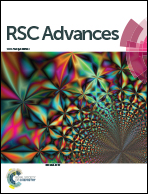Gold nanoparticle modified graphitic carbon nitride/multi-walled carbon nanotube (g-C3N4/CNTs/Au) hybrid photocatalysts for effective water splitting and degradation†
Abstract
Gold nanoparticles (Au) used for stable plasmonic photocatalysts in hybrids of Au, graphitic carbon nitride (g-C3N4), and carbon nanotubes (CNTs), were evaluated for effective photodegradation of organic pollutants and photoelectrochemical (PEC) water splitting. These hybrids are formed at room temperature using sonication, and were shown to be effective for photodegradation of Rhodamine B (RhB) under irradiation with visible light. The hybrid samples resulted in a significant increase in photocatalytic activity compared with single-component samples of g-C3N4. In particular, the g-C3N4/CNTs/Au hybrids exhibited an exponential increase in the photocatalytic activity by a factor of almost 40. Structural and compositional analyses show the successful formation of ternary g-C3N4/CNTs/Au hybrids. The SPR due to the Au nanoparticles led to high optical absorbance, and the inclusion of the CNTs led to effective separation of photogenerated charge carriers, resulting in substantial improvement of the photocatalytic properties. PEC measurements indicate effective use of charge carriers, and open-circuit voltage decay measurements demonstrated increased lifetime of the photogenerated charge carriers in the hybrid samples. The ternary g-C3N4/CNTs/Au sample resulted in a large specific surface area, providing a large number of active sites for the adsorption of organic molecules. Therefore, a facile and room temperature fabrication method was shown to introduce Au and CNTs in the hybrid for substantial improvement of photocatalytic activities and effective water splitting.


 Please wait while we load your content...
Please wait while we load your content...